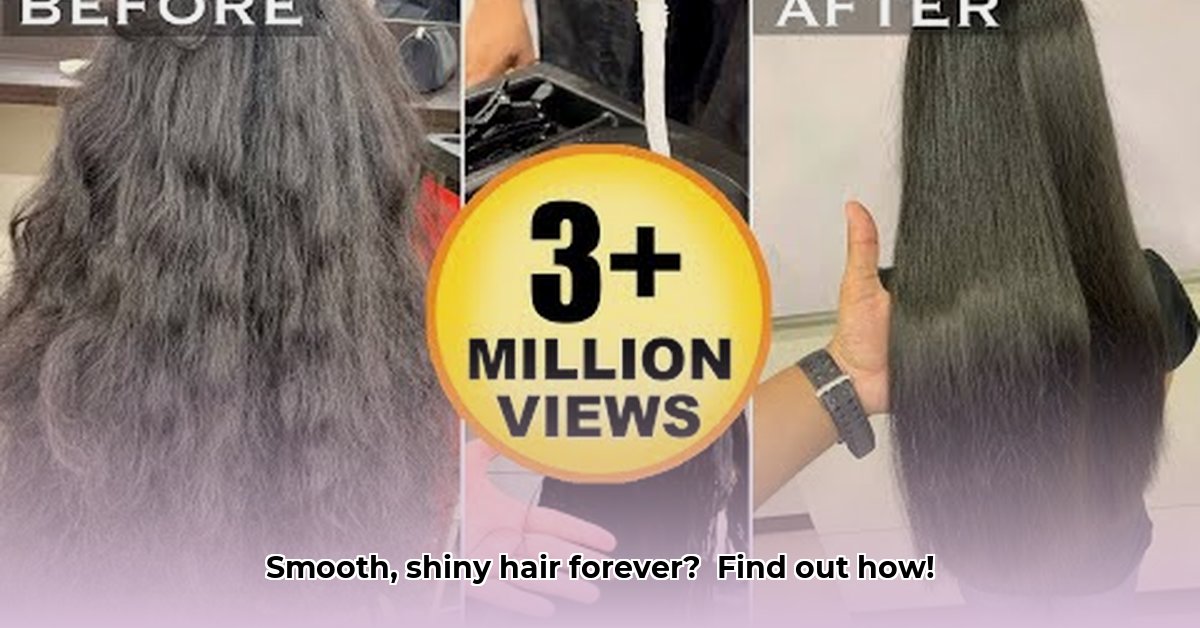Want smooth, shiny hair that’s easy to manage? Say goodbye to frizz and hello to effortless style with this guide to permanent hair smoothing treatments, where we explain the various types, pros, cons, and potential downsides to help you make smart choices for healthy, gorgeous hair. For those considering longer-term hair changes, see our guide on growing out gray hair.
Achieve Silky Hair: Understanding Permanent Hair Straightening Options
Dreaming of effortlessly smooth, shiny hair that practically glides? Let’s dive into the world of permanent hair straightening and explore your options, like Keratin treatments, Rebonding, and Relaxers. Getting permanently sleek locks involves understanding the methods available and choosing the one that’s right for you. It’s a journey, not just a quick fix, and knowing the ins and outs is key to achieving your desired look while preserving hair health!
Understanding Your Smoothing Options: Keratin, Rebonding, and Relaxers
Several techniques promise permanently smoother hair, each with its own strengths and weaknesses. Let’s break down the big three: keratin treatments, rebonding, and chemical relaxers.
- Keratin Treatments: Think of these as a gentler, temporary smoothing solution, lasting around 2-6 months. Keratin treatments infuse the hair with proteins, smoothing the cuticle, reducing frizz, and enhancing manageability. They’re an excellent starting point for those uncertain about commitment to more intense methods.
- Rebonding: This is a more dramatic and longer-lasting approach. Rebonding employs chemical solutions to break down and restructure the hair’s natural bonds, resulting in a significantly straighter appearance that lasts much longer than keratin treatments. Keep in mind that this intense process carries a higher risk of damage if not expertly executed by a skilled professional.
- Relaxers: Utilizing chemicals such as sodium hydroxide, relaxers permanently alter the hair’s structure. If your objective is bone-straight, sleek hair, this method could be suitable. However, it’s the most aggressive option with the highest risk of damage, requiring diligent aftercare to maintain hair health.
Fun Fact: Keratin treatments generally last between 2 and 6 months, acting as a temporary smoothing solution for individuals hesitant about more permanent options.
Choosing the Right Path: What’s Best For You?
Selecting the best smoothing method involves a variety of personal considerations. Let’s examine a few:
- Your Hair Type: Fine hair might not react favorably to harsh chemical treatments like rebonding or relaxers, while thicker, coarser hair may benefit more from these methods.
- Desired Straightness: Are you seeking a subtle smoothing effect, or perfectly straight hair? This preference will influence your decision between a gentler keratin treatment and a more aggressive rebonding or relaxer.
- Budget: Each method carries a different price tag. Keratin treatments are typically less expensive, while rebonding and relaxers tend to be pricier.
- Current Hair Condition: If your hair is already compromised from damage, color treatments, or chemical processes, exercise caution. Damaged hair is more susceptible to additional harm from chemical treatments.
A professional consultation with a skilled hairstylist is critical. They can accurately assess your hair’s condition, explore your desired results, and guide you toward the safest and most effective treatment.
Data Point: Consulting a professional hairstylist is essential, as they can assess your hair’s condition and recommend the safest, most effective treatment, thereby increasing your chances of a successful outcome.
Minimizing Risks and Maximizing Results: Post-Treatment Care
Regardless of the method chosen, aftercare is fundamentally important. Think of it as the cornerstone to preserving smooth, shiny results and preventing long-term damage. Here’s what you should focus on:
- Wash Wisely: Absolutely utilize sulfate-free shampoos and conditioners. Sulfates are harsh detergents that can strip your hair of natural oils, leading to dryness and potential damage.
- Heat Styling in Moderation: Minimize the use of flat irons, curling irons, and blow dryers. Excessive heat can negate the benefits of your smoothing treatment and weaken hair structure.
- Deep Conditioning: Routinely treat your hair to intensive deep conditioning treatments. This effectively replenishes lost moisture and aids in preventing breakage and dryness, particularly important after chemical treatments.
- Sun Protection: Did you know UV rays can also damage treated hair? Consider utilizing a leave-in conditioner that includes UV protection or wearing a stylish hat when spending time outdoors.
- Follow Your Stylist’s Instructions: Your stylist will provide specific recommendations tailored to your hair type and the treatment performed. Strict adherence to these instructions is essential for optimal results.
Permanent Hair Smoothing Treatments: A Quick Comparison
| Treatment Type | Permanence | Damage Potential | Cost | Maintenance | Best For |
|---|---|---|---|---|---|
| Keratin Treatment | Temporary (2-6 months) | Low to Moderate | Moderate | Relatively low | Reducing frizz, adding shine, easy manageability |
| Rebonding | Long-lasting (6+ months) | Moderate to High | High | Moderate to High | Achieving significant straightness |
| Relaxers | Permanent | High | Moderate to High | High | Bone-straight hair, coarse textures |
| At-Home Kits | Varies | High | Low | High, and riskier | Generally not recommended |
The Bottom Line: Making Informed Decisions
Permanent hair straightening offers excellent options for achieving manageable, sleek hair. However, adopting a carefully considered approach is essential. The ideal choice depends on your unique hair characteristics, desired level of smoothness or straightness, and pre-determined budget. Remember, partnering with a skilled, experienced stylist and diligently following their aftercare advice remains essential for preserving beautiful, healthy, and long-lasting results. Think of it as making an investment directly towards both your overall hair’s well-being, not just a simple cosmetic fix or procedure.
Rhetorical Question: Considering the long-term benefits juxtaposed with the potential risks, does permanent hair smoothing present a truly worthwhile option for you, and what specific preliminary steps can you actively take to rigorously ensure the health and prolonged integrity of your hair throughout this intricate chemical process?
How to Choose the Safest Hair Smoothing Treatment for Color-Treated Hair
Start by properly assessing your existing hair condition. Color-treated hair textures are already frequently and inherently more fragile, suggesting that choosing very gentle methods would lead to the best results. Rigorously but fairly consider your hair’s particular texture (ranging from fine, medium, to rather coarse), closely examine its overall porosity (directly relating to how efficiently it absorbs moisture), in addition to its current overall health condition (specifically noting if it’s currently damaged but healthy). This thorough self-assessment provides a reliable basis for confidently deciding which specific treatment would be most suitable and beneficial for your highly unique set of requirements. Considering your easily damageable fine, color-treated hair, opting for a gentler keratin treatment provides a far better alternative than risking severe damage via the use of harsher relaxers.
Key Takeaways:
- Permanent hair straightening profoundly alters the hair’s inherent structure.
- Choosing the perfect treatment hinges on thoroughly understanding both your base hair type and your long-term desired outcome.
- Although notably more secure in their application, be aware that formaldehyde-free alternatives often can’t provide the same degree of sleek straightening.
- Proper aftercare routines are absolutely crucial for actively maintaining resilient and optimally healthy, smooth hair.
- Always seek personalized direction via consulting an extensively knowledgeable professional stylist to fully leverage their in depth, hands-on experience and advice.
Exploring Treatment Options
Numerous nuanced methods can permanently straighten the hair; each contains a complex combination of distinct risks coupled with unique benefits. The following section provides a brief summary and overview of several common treatments:
| Treatment Type | Description | Pros | Cons | Suitability for Color-Treated Hair |
|---|---|---|---|---|
| Keratin Treatments | Smooths fragile, porous hair temporarily by infusing keratin proteins. | Enhances shine, actively reduces current frizz, with relatively gentle methods employed. | Yields temporary results (usually from 2-6 months), may still contain trace formaldehyde derivatives. | Excellent if formaldehyde-free. |
| Japanese Straightening | Intensely and radically alters existing hair bonds by utilizing strong chemicals. | Delivers permanent results spanning all hair and derived-hair types. | Exhibits a high-end heightened risk of severely damaging already fragile color-treated hair. | Only proceed with extreme caution. |
| Relaxers | Chemically applied relaxers act to permanently straighten existing hair shafts. | Results in permanent changes, proving relatively more cost-effective. | Presents a significantly increased risk of causing damage, severely impacting long-term texture. | Generally not recommended. |
How to Choose the Safest Hair Smoothing Treatment for Color Treated Hair
Prioritize and select primarily formaldehyde-free options; formaldehyde is a notoriously well-known carcinogen found in several commonly utilized smoothing treatments, which can pose substantial health risks. Diligently research both product and salon specifics, and actively inquire about current and prospective ingredients when directly consulting staff. Read thoroughly many user reviews to accurately gauge others’ real experiences.
- Unlock Young Doctors’ Work-Life Balance: Actionable Strategies Now - December 2, 2025
- Unlock Life Harmony: Work-Life Integration Guide - November 30, 2025
- Unlock Work-Life Harmony:Your Guide to Integration - November 27, 2025
















